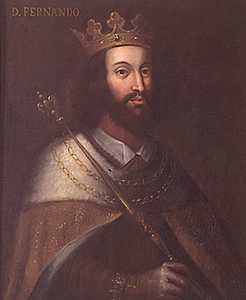Fernando of Portugal
|
|
Fernando I, ninth king of Portugal (Eng. Ferdinand I), sometimes referred to as the Beautiful (Port. o Formoso) or rarely as the Inconstant (Port. o Inconstante), was born on October 31 1345. He was the son of Pedro I of Portugal (who should not to be confused with his Spanish contemporary Pedro the Cruel) and his wife, princess Constance of Castile. He succeeded his father in 1367 and died on October 22 1383 in the city where he was born - Lisbon.
On the death of Pedro of Castile in 1369, Ferdinand, as great grandson of Sancho IV by the female line, laid claim to the vacant throne, for which the kings of Aragon and Navarre, and afterwards John of Gaunt, duke of Lancaster (married in 1370 to Constance, the eldest daughter of Pedro), also became competitors.
Meanwhile Henry of Trastamara, the brother (illegitimate) and conqueror of Pedro, had assumed the crown and taken the field. After one or two indecisive campaigns, all parties were ready to accept the mediation of Pope Gregory XI. The conditions of the treaty, ratified in 1371, included a marriage between Ferdinand and Leonora of Castile. But before the union could take place the former had become passionately attached to Leonor Telles de Menezes, the wife of one of his own courtiers, and having procured a dissolution of her previous marriage, he lost no time in making her his queen.
This strange conduct, although it raised a serious insurrection in Portugal, did not at once result in a war with Henry; but the outward concord was soon disturbed by the intrigues of the duke of Lancaster, who prevailed on Ferdinand to enter into a secret treaty for the expulsion of Henry from his throne. The war which followed was unsuccessful; and peace was again made in 1373. On the death of Henry in 1379, the duke of Lancaster once more put forward his claims, and again found an ally in Portugal; but, according to the Continental annalists, the English proved as offensive to their companions in arms as to their enemies in the field; and Ferdinand made a peace for himself at Badajoz in 1382, its being stipulated that Beatrice, the heiress of Ferdinand, should marry King John I of Castile, and thus secure the ultimate union of the crowns.
Ferdinand left no male heir when he died on October 22 1383, and the direct Burgundian line, which had been in possession of the throne since the days of Count Henry (about 1112), became extinct. The stipulations of the treaty of Badajoz were set aside, and João, grand-master of the order of Aviz, Ferdinand's illegitimate brother, claimed the throne. This led to a period of war and political indefinition known as the 1383-1385 Crisis. João became the first king of the House of Aviz in 1385.
Fernando's descendants
- From his wife, Leonor Telles de Menezes
- Beatrice of Portugal, heiress of Ferdinand married to king John I of Castile
- Pedro (1380)
- Afonso (1382)
See also: Kings of Portugal family tree
| Preceded by: Peter I | King of Portugal | Succeeded by: John I |
de:Ferdinand I. (Portugal) fr:Ferdinand Ier de Portugal pl:Ferdynand (król Portugalii) pt:Fernando I de Portugal

